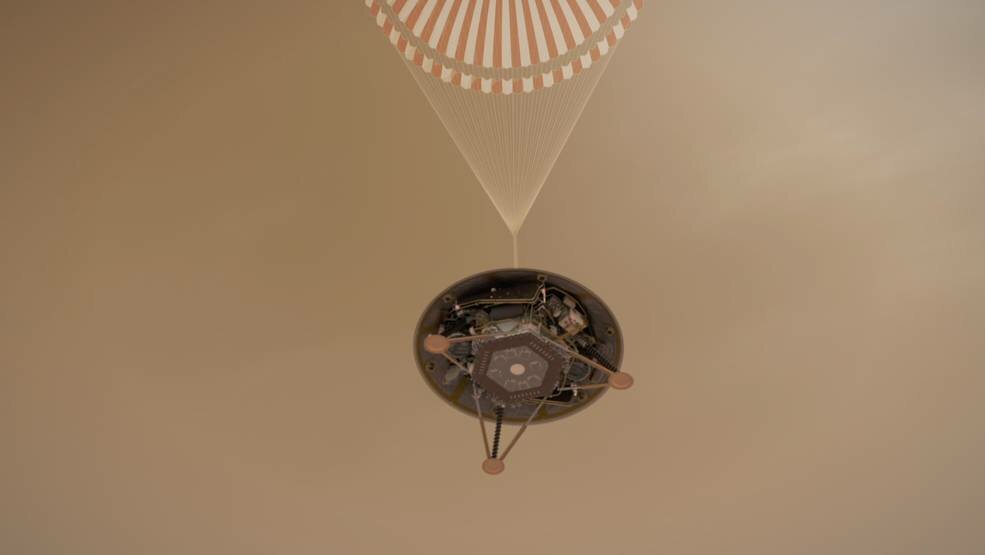NASA Has Officially Landed On Mars
📸 Wish you were here! @NASAInSight sent home its first photo after #MarsLanding:
InSight’s view is a flat, smooth expanse called Elysium Planitia, but its workspace is below the surface, where it will study Mars’ deep interior. pic.twitter.com/3EU70jXQJw
— NASA (@NASA) November 26, 2018
It’s official: NASA has landed what it has titled its InSight lander on the planet Mars, according to them.
According to NASA, the craft was able to execute a “perfect” landing after its trip to the fourth planet from the Sun, and they report it is functioning perfectly.
Mars is notorious for being a difficult place to land a craft like this, according to NASA and these people who we admittedly rely on for information about things like this, which should be examined and tested to the fullest as well. Out of 17 previous missions to Mars, 10 of them failed to land properly, so it hasn’t been that easy to accomplish the feat, if we are to believe the official narrative. Keep in mind these images are illustrations, not photos.
So NASA engineers had to really be careful with the details of this space craft, InSight and its satellites, particularly during something they call the “seven minutes of terror,” the moment when a spacecraft enters Mars’ atmosphere.
Previously, Thomas Zurbuchen, the science chief of NASA said “As humanity, as explorers – we’re batting at less than 50 percent. Going to Mars is really, really hard.” That’s the way NASA makes their work feel, like the accomplishment of everyone, but don’t forget it’s a government agency. In any case, discoveries about space are wholesome and interesting.
Touchdown upon the red planet was recorded at 19:50GMT, or 11:54 am Pacific Time because it probably took approximately 4 minutes to be completed, which initiated a burst of celebration from NASA. Already the lander beamed the first image of the planet down to Earth, but it doesn’t seem to have been released yet.

(Image credit: NASA)
On May 5, NASA used a rocket to launch that craft described as a “789-pound robot” toward Mars, along with two satellites roughly the size of a briefcase, called Mars Cube One, following behind the spacecraft in order to provide assistance in recording and relaying critical landing data.
This was the first successful landing on Mars since the nuclear-powered Curiosity rover, which reached Mars over six years ago.
Now, a much more high tech robot is on the surface of Mars. The different things they can do seem like an enormous spectrum of possibility now, if their word is to be trusted and people should definitely test what NASA says with some basic skepticism.
“We’re going to kick up a lot of dust when we land, and we need to let that dust settle before we want to unfurl our solar arrays,” the InSight mission’s payload manager, Tom Hoffman said during a NASA live broadcast. “We’re 100% solar-powered, so it’s very important that we get those out.”
Over the next two years, as long as everything goes well the spacecraft will be ready to probe Mars and discover who knows what, in “ways researchers had only dreamed about,” as one article puts it.
“InSight’s a very different mission in the sense that it is peering into the past by studying, really, the interior of Mars,” said a former chief technologist at NASA and a technical consultant for a National Geographic seines about Mars. “In doing so, we’re going to learn about Mars, but also about the early history of the Earth.”
So where did InSight land? It went to Elysium Planitia, a pretty flat region that is largely free of craters, boulders, and other potential obstacles to the success of the mission.
The region rests directly north of the equator on Mars, and that’s where the rays of the Sun are quite bright the entire year. That means the solar panels on the craft could enable it to function for about two years, a pretty long time.
Different scientific instruments are present on the craft, and researchers believe the soil there at Elysium Planitia will be loose enough for the robot to dig a little bit into the ground and insert a heat probe.
As you can see, it sounds like this thing could discover quite a few things about Mars that we don’t know. Just as long as people try to reason through the discoveries themselves rather than taking someone’s word for it.
